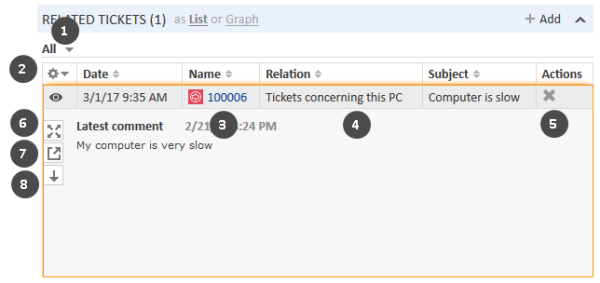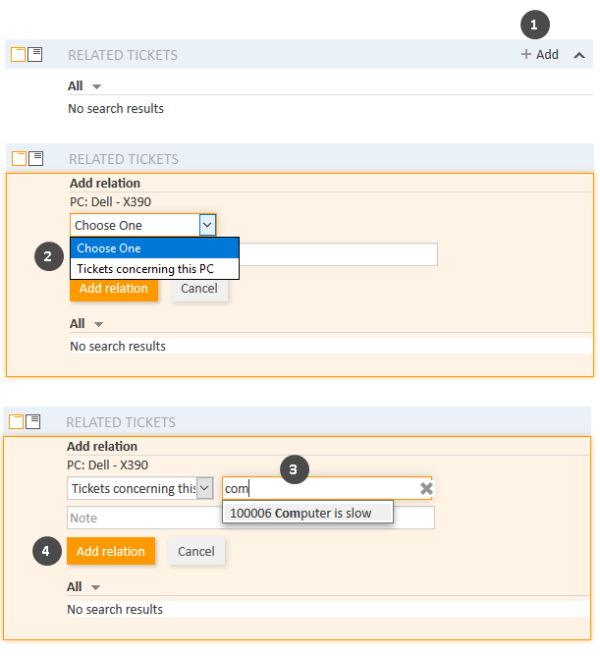Resource-case relations
Introduction
A resource-case relation (for greater readability called case relation in this section) defines the relation between this resource and a case. Case relations allow you to link your assets to the cases concerning them. For example, you can link an incident case to the printer which caused the problem or a service case to the contact's SLA. You can quickly access the cases from the resource page.
You can create relations based on the relation models which are configured in your CM system. The following is defined for each relation model:
- The process which the case has to be in.
- The cardinality of the relation, i.e., if you can link several resources to the same case, or several cases to the same resource.
- Whether the relation name is displayed.
- Whether the relation is editable, i.e., whether it can be added, edited and deleted in the Web Client.
Display of case relations
Case relations are displayed in the section for related cases of the resource page. The table contains the relations which were created for this resource. You can choose to display all cases, open cases or closed cases by selecting the corresponding value in the filter (1). To configure the table columns, click the tool icon (2) and select the desired columns. You can order the columns by dragging the column header to the required position.
The table usually contains a link to open the case (3), the name of the relation (4) and an icon to delete the relation (5). Click a table row to open the case preview. The case preview contains buttons to display more case data (6), open the case (7) and display the preview of the next case (8).
Figure 125: Case relations
You can also show a relation graph in this section.
Configuring the columns
You can resize the table columns by dragging each column to the desired width.
Open the context menu next to the wheel icon to configure the table columns. To add columns, enter the column name and select a suggestion from the Autocomplete Search. You can remove columns by clicking the cross next to their name.
Adding a case relation
Please proceed as follows to add a new case relation.
Figure 126: Adding a case relation
- Click the Add link in the section header.
- Select the desired relation model from the drop-down list.
- Start typing the name of the case and select the desired case from the suggestions of the Autocomplete Search in the Unassigned field. Optionally, you can enter a note.
- Click Add relation.
The action of adding or deleting a relation can trigger additional changes, e.g., the value of a data field can be updated. This depends on the individual configuration of your CM system.
Editing the note of a case relation
Click Edit in the Note column of the relation to add or edit its note. The note is optional. If the Note column is not displayed, you have to add it first (see Configuring the columns).
Opening the case
You can open the related case by clicking its number in the column Name. If you click another column, a preview window is opened where you can choose to open the case (see figure in section Display of case relations).
Deleting a case relation
Click the cross in the Actions column to delete the relation. Then, click OK in the red field to confirm the removal. Note that the relation is also removed from the page of the related case. You cannot undo the removal once you confirmed it.
The action of adding or deleting a relation can trigger additional changes, e.g., the value of a data field can be updated. This depends on the individual configuration of your CM system.

